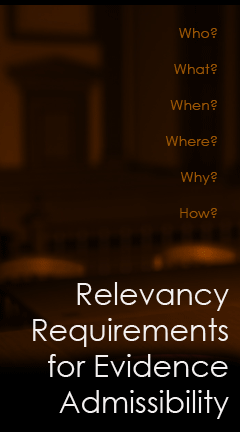Archival Notice
This is an archive page that is no longer being updated. It may contain outdated information and links may no longer function as originally intended.
Home | Glossary | Resources | Help | Course Map
In order to be admissible, evidence must:
- Be authentic.
- Be in good condition.
- Be able to withstand scrutiny of its collection and preservation procedures.
- Be presented into the courtroom in specific ways.
All of those requirements are intended to ensure that the fact finder makes his decisions on the basis of reliable information.
Admissible evidence is what it purports to be: It is genuine and not fabricated, contrived, forged or materially altered.
Admissible evidence is offered by an attorney as founded on an indicator of authenticity: A witness or a rule is used to confirm that the evidence is what it is asserted to be.
Evidence is admitted for trial, once the circumstances of collection and preservation are identified:
- Who seized it?
- When was it seized?
- Where has it been since then?
- How was it preserved?
- What records exist that confirm the preservation?
Evidence is admitted on the appropriate basis: either testimony from a witness or application of a rule or an agreement.
Most, if not all, of the conditions and circumstances required for evidence admission are established by foundational or predicate questions and/or records.
Before the ultimate question may be asked or the physical object may be shown to the jury or judge, several foundational facts must be established by the attorney seeking its admission. Often, these establishing facts provide answers to the most basic questions:
- Who?
- What?
- When?
- Where?
- Why?
- How?
Foundational questions must be answered before items created by an expert witness can be admitted as evidence, including the expert's own data, report or opinion.
Additional Online Courses
- What Every First Responding Officer Should Know About DNA Evidence
- Collecting DNA Evidence at Property Crime Scenes
- DNA – A Prosecutor’s Practice Notebook
- Crime Scene and DNA Basics
- Laboratory Safety Programs
- DNA Amplification
- Population Genetics and Statistics
- Non-STR DNA Markers: SNPs, Y-STRs, LCN and mtDNA
- Firearms Examiner Training
- Forensic DNA Education for Law Enforcement Decisionmakers
- What Every Investigator and Evidence Technician Should Know About DNA Evidence
- Principles of Forensic DNA for Officers of the Court
- Law 101: Legal Guide for the Forensic Expert
- Laboratory Orientation and Testing of Body Fluids and Tissues
- DNA Extraction and Quantitation
- STR Data Analysis and Interpretation
- Communication Skills, Report Writing, and Courtroom Testimony
- Español for Law Enforcement
- Amplified DNA Product Separation for Forensic Analysts


